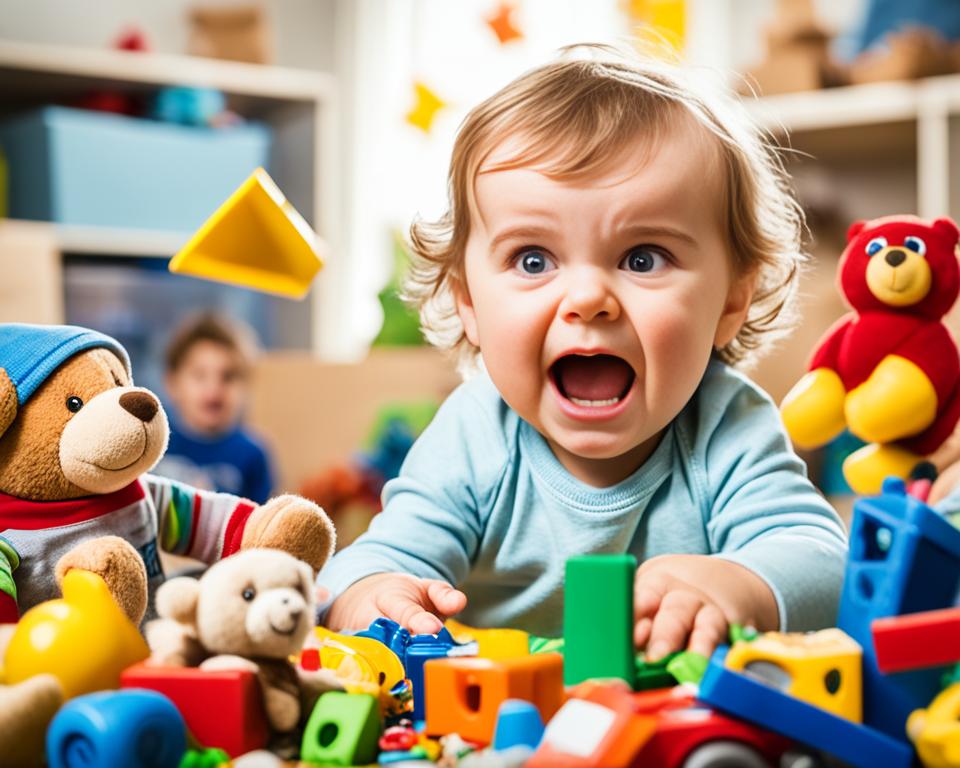It's crucial to know that students with autism and ADHD need special study strategies. Autism…

Understanding Toy Throwing and Autism Signs
For many parents, noticing unusual play behaviors in their young ones can prompt questions about development. If your child prefers order over chaos during playtime or engages in repetitive actions, understanding these signs of autism in children can be enlightening.
Atypical play, such as arranging toys neatly instead of engaging in imaginative scenarios, can be among the early signs of autism in toddlers. Recognizing these autism symptoms is vital for parents and caregivers seeking an autism diagnosis.
Where neurotypical children might immerse themselves in interactive and imaginative games, those with autism may find comfort and self-regulation in sameness and repetition. These behaviors are not only indicative of how autistic children experience play but can also shed light on the ways they process sensory input and navigate their surroundings. So when it comes to actions like toy throwing, it’s essential to consider the context and possible motivations behind them to better understand and support your child’s unique needs.
Autism Spectrum Disorder and Repetitive Play Behaviors
Exploring the nuances of play among children with autism spectrum disorder reveals a landscape rich with patterns and preferences unique to their experience. Repetitive behaviors in autism, which can range from strict adherence to routines to an insistence on sameness, serve more than just a compulsive need; they provide comfort and predictability in a world that often feels chaotic for those with sensory issues in autism.
Characteristics of Autism-Related Play
When it comes to play, autistic children might exhibit behaviors that are distinct from their peers. A focus on repetitive action be it the methodical lining up of toy cars or the consistent act of building and knocking down blocks is a common characteristic. These routines are not only a reflection of their meticulous nature but also represent an essential coping mechanism. Sensory issues in autism frequently push these children to find solace and self-regulation through such repetitive play.
Impact on Social and Communication Skills Development
The social skills in autism that are cultivated through play can be impacted by the atypical play habits demonstrated by those on the autism spectrum. While neurotypical children gradually evolve from playing alone to engaging with others, this transition might pose a significant challenge for children experiencing developmental delay, including speech delay in autism. Their play behaviors often hinder spontaneous social interaction, which subsequently affects their language development and the intuitive grasp of the give-and-take nature of human communication.
Therapeutic Play Interventions for Children with Autism
Addressing these developmental challenges necessitates specialized play therapies for autism. The Floortime method draws on the child’s own interests at their level, encouraging engagements that spark connection and understanding. Similarly, Relationship Development Intervention (RDI) and The PLAY Project focus on enhancing social skills through play-based strategies, each emphasizing the pivotal role of relationship-building and engagement in the developmental process. These interventions acknowledge the intrinsic play styles of autistic children and are designed to not only expand their play activities but improve their social connectivity as well.
Is Throwing Toys a Sign of Autism?
Observing a child throwing toys may lead to questions about typical childhood behavior versus potential signs of autism in children. While such actions can occur for various reasons unrelated to autism, they can also be an indication of sensory processing issues or unique communication needs often associated with autism spectrum disorder (ASD). Understanding the context and frequency of these behaviors is vital, especially when considering an autism diagnosis.
Parents and caregivers often wonder if is throwing toys a sign of autism when they see their child repeatedly engaging in this behavior. Discerning the motivation behind throwing toys can be complex. It may be a form of sensory-seeking behavior, a reaction to emotional overwhelm, or a nonverbal method of communication. Each of these possibilities requires a nuanced understanding and approach.
- Sensory-seeking behavior may involve throwing toys to experience the visual stimulus of flying objects or the auditory feedback of items hitting the floor.
- An emotional response could indicate frustration or difficulty in expressing feelings with words, leading to throwing toys as a release of pent-up energy.
- As an act of communication, throwing toys might be a child’s way of signaling a need or desire when verbal language is not accessible or effective.
Professionals typically use Applied Behavior Analysis (ABA) as a tool to investigate and address these behaviors. ABA therapists work to identify the root causes of actions like toy throwing and develop personalized strategies to teach alternative, more constructive coping skills.
If a child demonstrates this behavior alongside other potential autism indicators, it is recommended to seek a professional evaluation. A thorough assessment by a specialist can discern whether toy throwing is part of a larger pattern of behaviors consistent with ASD.

Conclusion
Understanding the signs of autism in children, including early signs of autism in toddlers, is a complex and nuanced endeavor. Observing behaviors such as toy-throwing in young children can stir concerns for parents and caregivers, particularly when evaluating for possible markers of autism spectrum disorder. Recognizing the importance of embracing each child’s individual way of expressing themselves, whether through traditional or non-traditional forms of communication and play, is a critical step in providing the right support and guidance.
Embracing Different Forms of Play and Communication
Children with autism display a vibrant tapestry of behaviors and interactions. While some movements like toy-throwing might be misunderstood, these actions often convey deeper emotional and sensory needs characteristic of autism symptoms. Acknowledging and accepting this diversity in play helps us see the world through their eyes, offering a chance to align our support strategies with their unique developmental journey. Amidst the challenges, providing autism support tailored to their personal communication and play patterns nurtures not only their growth but also our own understanding.
Strategies for Managing and Redirecting Throwing Behaviors
Managing autism behaviors, such as toy-throwing, requires a gentle and consistent strategy. Understanding what triggers certain actions gives caregivers the ability to craft an environment adept at redirecting throwing autism behaviors towards more positive expressions. Employing visual aids, verbal encouragement, and engaging in joint attention activities can significantly reinforce preferred behaviors. These methods of intervention promote skill development and play a vital role in helping children navigate and make sense of their world.
Supporting Your Child’s Unique Developmental Journey
Every child’s developmental path is unique, especially for those navigating the world with autism. Recognizing this, it is important to seek an autism diagnosis if needed, embrace early signs with a caring approach, and seek professional support when necessary. Therapies such as ABA can provide substantial assistance, enabling children and families to understand and manage behaviors effectively. Ultimately, being proactive in seeking autism support can pave the way for children to achieve their full potential, turning each challenge into a stepping stone toward greater self-reliance and confidence.
FAQs
What are some early signs of autism in toddlers?
Some early signs of autism in toddlers include lack of eye contact, delayed speech development or nonverbal communication, resistance to cuddling, not responding to their name, unusual reactions to sensory experiences, and repetitive behaviors. Variations in play, such as a lack of pretend play, could also indicate autism.
Can throwing toys be a sign of autism?
While throwing toys can be common in many children, if it is part of a pattern of repetitive behaviors or if a child throws toys because they’re overly sensitive to sensory input, it could be a sign of autism. It’s important to look at this behavior within the broader context of the child’s development and other autism symptoms.
How is autism diagnosed in children?
Autism is typically diagnosed through a combination of assessments including behavioral evaluations, developmental screenings, and parental reports of a child’s developmental history. A healthcare professional will look at the child’s symptoms, developmental level, and how their behavior differs from that of neurotypical peers their age.
What is repetitive behavior in autism?
Repetitive behaviors in autism are actions that are done over and over again in a similar manner. These can include rocking, spinning, hand-flapping, lining up toys, and repeating phrases or sounds. These behaviors often serve a self-regulatory purpose for the individual with autism.
Are there sensory issues associated with autism?
Yes, many individuals on the autism spectrum experience sensory issues. They may be hypersensitive or hyposensitive to sensory stimuli like sounds, lights, touch, tastes, and smells. This can manifest as either an avoidance of certain sensory experiences or a seeking out of certain sensory input.
How does autism spectrum disorder impact social skills and communication?
Autism spectrum disorder can affect social skills, making it challenging for individuals to engage in social interactions, read non-verbal cues, and develop friendships. It can also impact communication, with some individuals having significant speech delays or difficulties with conversational skills.
What are some common play therapies for autism?
Common play therapies for autism include the Floortime method, Relationship Development Intervention (RDI), and The PLAY Project. These therapies focus on engaging children with autism in play activities that promote social interaction, communication, and emotional growth.
What strategies can help manage throwing behaviors in children with autism?
Strategies to manage throwing behaviors include identifying triggers that lead to throwing, reinforcing alternative behaviors, using visual supports to communicate rules and expectations, and engaging the child in sensory activities that fulfill their sensory needs in a more appropriate way.



This Post Has 0 Comments